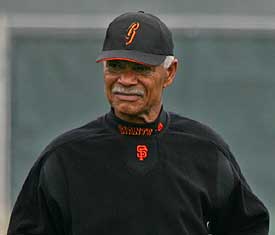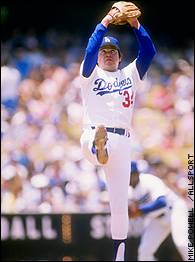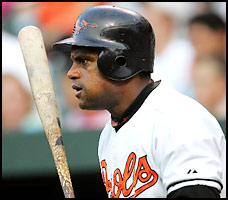Latinos and Barriers in Baseball
Felipe Alou, manager of the San Francisco Giants
History of Latinos and Baseball
Baseball found its roots in the lives of Latinos as an expression of anti-Spanish, pro-American sentiment. What better way to show support of Americans than by adopting their favorite sport: Baseball. Cuban children, who went to school in the United States , would learn how to play the game, and in turn, teach other Cubans when they returned to Cuba . The game was fun and addictive and, unsurprisingly, spread quickly throughout the entire Caribbean .
Over the years, Cubans began to form baseball teams and leagues. In 1909, Cubans gained recognition of their baseball talents when the Cincinnati Reds flew to Cuba to play a few exhibition games. Americans were shocked when they saw José de la Caridad Méndez pitch the ball. He shut down a professional American baseball team for 25 straight innings. This Cuban superstar opened the doors for other Cubans to be scouted by Major League Baseball scouts and eventually play in the MLB.
Due to racial barriers in the US throughout the early 20th century, only light skinned Cubans were permitted to play in the league. Adolfo Luque, a white Cuban, became the first Latin star playing in the Major League. His career spanned 30 seasons as a player and manager. Baseball in the US was finally de-segregated in 1947 when Jackie Robinson suited up for the Brooklyn Dodgers. The majors finally opened up to Minoso and other black Latinos.
Baseball became the favorite pastime in Latin countries just as it had in the US . There was something about the game that captivated young Latinos. "Just like any kid in the Dominican Republic - then and now - this bug, or whatever it is about the game, runs in the veins of every Dominican boy," says Felipe Alou. Alou and his brother Matty dominated the National League throughout the 1960s. They played despite growing up in devastating poverty, using sugar cane and broomsticks for bats, coconuts and fruit for balls, and cow chips for bases. Klores
According to author Peter Bjarkman, the 1980s saw an explosion of Latino ballplayers, led by the phenomena of "Fernandomania." In 1981, 20-year-old Los Angeles Dodgers pitcher Fernando Valenzuela emerged from the Mexican leagues as a star, throwing eight shutouts, which tied a rookie record. Valenzuela was a hero to Latinos in Southern California, where gained the heroric-status. "With the arrival of Valenzuela, [thousands] of Spanish-speaking residents of southern California were finally able to identify fully with their own true homegrown superstar and ethnic folk hero." (3)
Baseball has quickly accepted Latino presence in the sports. On the 1999 opening day rosters, 17.4 percent of the 841 major league players were born in Spanish-speaking countries outside of the United States . They came from the Dominican Republic (66), Puerto Rico (31), Venezuela (25), Mexico (12), Cuba (8), Panama (6), Colombia (3), and Nicaragua (1). Even though a visa quota system limits the number of Hispanics baseball teams can bring into this country, the number of Hispanic players continues to grow. The skills of these players have not been overlooked by the American public due to their large numbers. In 1998, Sammy Sosa, a Dominican, won the National League MVP award and Juan Gonzalez, a Puerto Rican, won the American League MVP award. It was the first time in history that the MVP in both leagues went to Latin-born players in the same year. (5)
Los Angeles Dodgers pitcher Fernando Valenzuela
This demographic shift of Hispanics into baseball reflects a larger demographic movement of Hispanics from all over Latin America into the United States . Such a large demographic shift of a group that speaks a language other than English has raised many issues about Spanish, English, and the language barrier throughout the country.
Cultural and Language Barriers
The cultural barrier in baseball has been an issue for Latinos for quite some time. Many Latinos in the United States look up to baseball players as their role models and negotiators of societal relations between Americans and Latinos. Once identity issues are resolved at the level of prominent baseball athletes, the rest of society follows the path set by these conquerors. In a sense, baseball is a microcosm of society. The cultural barrier within baseball reflects the same barrier present in American society.
Even though baseball players are teammates and are ideally supposed to regard each other as family, cultural barriers have proven to be an obstacle in this quest. Latino ballplayers who start their careers with minor league teams find themselves in “minor league” cities. Their first stops were at such spots as Yakima, Washington; Butte, Montana; and Lake Charles, Louisiana among others. These spots were as foreign to them as if they had landed on the moon. (6) These cities lack Latino communities such as those that tend to develop in large metropolitan cities such as Los Angeles , Miami , and New York . As a result, Latino baseball players often find themselves in isolation. "Because they came individually, to disparate cities across the United States , most of which had no Latin neighborhoods, they were islands unto themselves." (5)
The language barrier led to depressing isolation and alienation from the community. Many everyday activities such as ordering food were very difficult. It seemed like everyday was a fight for survival. Traveling between cities was also difficult. Many times, these Latinos would not understand travel directions and get lost. One team owner tried to prevent this by hanging signs with their destinations around their head. These signs did not help assimilate Latinos into society.
“There is a unique power to the aloneness that comes from not being able to communicate. It is always possible to use sign language to establish a rudimentary acquaintance, to exploit the few words one does know, but when these shallow wells of contact are evaporated there remains only the uneasy helpless shrug, the look of futility, the nod, wave or handshake of goodbye.” These sentiments of Alou reflect many of the same feelings expressed by Latinos, especially the early pioneers.
“There is a marked tendency for exclusive grouping based on nationality, and this is, of course, underwritten by the inability to communicate. Even when the chasm is bridged and players attempt to interact, there is a withered quality to it that is particularly telling in the context of baseball life. Asked if they ever socialize with Imports outside of the game, one veteran replied, ‘Oh yes, sometimes if they invite us we all go: rookies, Americans, and veterans. Yes, sometimes I take a walk with the American players.' To understand this more fully, one has to recall just how much downtime there is in baseball. Players have so much opportunity to hang around together so often that they can find all manner of mischief to get into, so ‘taking a walk' with Americans constitutes a particularly paltry moment shared among players, and underscores the nature of these relations.”
In addition to the isolation due to not knowing the language, many Americans discriminate against Latino baseball players simply because they do not know how to speak English.
Hints of this heightened discrimination and xenophobia based on language and foreignness were seen in the controversies surrounding 1998's homerun record race. Many thought that the media was biased and that Major League Baseball was acting like "an old, white, male organization" due to the lop-sided amount of attention McGuire received. There were many shouts of discrimination. However, the central characteristic that many thought caused Sosa to receive less attention was not the fact that he was black, it was the fact that he did not speak English as his primary language and that he was an "outsider."
Baltimore Orioles rightfielder Sammy Sosa
These conclusions were based on comparisons with coverage that Ken Griffey, Jr., an African American, had received in the homerun races he had with Mark McGuire in the years before. They were also based on predictions that if Griffey was in Sosa's shoes in 1998, that he would have received as much attention as McGuire. "Radio talk shows in Latin communities are screaming discrimination. The thrust being that if Sosa were White or even an African-American like, say, Ken Griffey Jr., that baseball would have treated him differently." The difference between Sosa and Griffey was not their race, but rather their language and national origin. For some, this outsider status was the reason Sosa's accomplishments were overlooked. People simply didn't like the fact that Sosa, a foreigner even though he was an American citizen, challenged the home run mark of the all-American game. (5)
Another cultural issue that segregated Americans and Latinos was the differing levels of homophobia. As we learned in class, Latinos consider homosexuality in two ways: those that are passive homosexuals and those that are active. In America , such distinguishing features do not exist and so anyone that displays any type of “homosexual” qualities will be labeled a homosexual. This was quite evident in the remarks of a Mexican Teco: "When I went to spring training in the States," said the Mexican, "I remember once putting my arm around one of the gringos who was a good guy. He looked at me like—[face recoiling in horror]. I thought he just didn't like me and I was surprised because we got along good, but now maybe I understand this thing better." The American resented the Mexicans physical affection towards him.
When two groups of people raised in different cultures are brought together as a team, differences in the norms of communication can lead to misunderstanding and divide the groups even further.
The Media
The relationship between Latin baseball players and the media seems to have always been one of friction due to the language barrier. Although the media has improved since they first started interviewing Hispanic ball players, they have consistently misunderstood, misrepresented, and ridiculed these players because they cannot understand them. This lack of willingness to understand the Latin players by having translators present has led to hostility over misinterpretations of comments due to media ignorance.
Some reporters have admitted that miscommunication caused the Hispanic players to be portrayed poorly but said the fault should lay on both the reporters' and the players' shoulders. "I thought a lot of that was that they were misunderstood because many Latinos were clannish, and they stuck to themselves.”
These language stereotypes portrayed Latino ballplayers as being stupid and comical characters. Reporters even mocked the athletes by writing their responses phonetically, and thus amplified their struggles.
The Sporting News reported a conversation between Mike Gonzalez and a hotel clerk when the Cuban attempted to order sauerkraut juice. The conversation in print made Gonzalez appear stupid: "Sakaraka juice, sakaraka juice," Mike bellowed again and again until finally the Cuban slammed down the receiver in disgust. "Damphool down there…," Mike finally sputtered. "I keep tolding her sakaraka juice, sakaraka juice, but no understand English." Thirty years later in 1969, Roberto Clemente was also victimized by such actions by the media. In one interview his words were presented exceptionally cruelly: "I no play so gut yet. Me like hot weather, veree hot. I no run fast cold weather. No get warm in cold. No get warm, no play gut. You see." Such quotes embarrassed and angered Clemente. He later responded, "I never talk like that; they just want to sell newspapers. Anytime a fellow comes from Puerto Rico , they want to create an image. They say ‘Hey. He talks funny!' But they go to Puerto Rico and they don't talk like us. I don't have a master's degree, but I'm not a dumb-head and I don't want no bullshit from anyone." (5)
While the use of phonetic quotes in these ways seems to have occurred less after the days of Roberto Clemente, many insensitive stereotypes still persisted. When pitcher Fernando Valenzuela became an overnight phenomenon in 1981, drawing thousands of Hispanics in Southern California to the Dodgers' stadium, the cultural awareness of the media was put to the test: "I wrote a burrito line on opening day," admitted Mark Heisler of the Los Angeles Times , "All of us knew better than to have used a watermelon reference in a story concerning blacks, but we were less prepared to deal with Latin sensibilities." The press was so insensitive that only weeks after Valenzuela's opening day victory over the Houston Astros, George Vecsey felt relief at the rookie's inability to read English: "As long as reporters and editors permit phrases like ‘Valenzuela had flicked aside the Houston Astros like so many flies on his plate of tortilla'…it is just as well that he does not read English. Otherwise," he warned, "he might get the idea some North Americans carry around unpleasant stereotypes of Mexicans." (4)
Latinos also experienced discrimination through blatant disregard for their names. Before players assimilated into American society, baseball officials and the media changed Latino players' names to sound more American. Roberto Clemente was nicknamed Bob. Bob is another way of saying Robert, which is not Roberto. Also, Bob was very similar to bobo, which in Spanish translated to “stupid person.” He did not want to be compared to a “bobo”. (1)
Such discriminations based on language have been a great impediment to Latino's quest to assimilate into American society.
Despite all the hardships that Hispanic major leaguers have experienced, baseball must now change to meet their needs. The changing demographics of America and, in particular, baseball fans demands that the franchises of Major League Baseball embrace Spanish as an essential language in its communications, marketing, and team relations. They must now learn to speak the language of béisbol.
[Home] [Baseball] [Basketball] [Football] [Hockey] [Image Gallery] [Bibliography]


